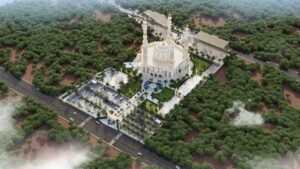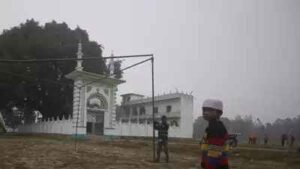The Indo-Islamic Cultural Foundation will begin building a magnificent mosque in Ayodhya in May of this year. It’s estimated to take three to four years to finish. The news broke on the day Prime Minister Narendra Modi was scheduled to preside over the Ram Temple’s consecration ceremony.
Haji Arfat Shaikh, the head of the Indo-Islamic Cultural Foundation’s (IICF) development committee, which is in charge of the mosque project, provided the information. He stated that a crowd-funding website is likely to be established to raise donations for the proposed mosque.

The mosque will be called “Masjid Muhammed bin Abdullah” after Prophet Muhammad’s father.
“Our effort has been to end and convert enmity, hatred among people into love for each other…irrespective of whether or not you accept the Supreme Court judgment,” he stated.
“All this fighting will stop if we teach good things to our children and people,” he went on to say.
The Supreme Court of India ruled in 2019 that the demolition of the Babri Masjid in 1992 was illegal. However, it determined that there was a non-Islamic construction beneath the Babri Mosque. It determined that a temple would be erected on the disputed site, while the Muslim side would be given a plot of ground to build a mosque.
Plans to build a mosque
The Indo-Islamic Cultural Foundation (IICF), which plans to build the replacement for the Babri Masjid 25 km from the existing site, hopes so. To begin with, they will not call it after Babur, the conqueror. Instead, it will be named Muhammad Bin Abdullah Masjid after the Prophet’s father.
The plan is to transform the 11-acre land in Dhannipur hamlet into a multicultural center of ‘dawa’ (medicine) and ‘dua’ (prayer). They received 5 acres from the government, and the Sunni Waqf Board added an adjoining 6-acre tract. In addition to the huge mosque located amid gardens and fountains, plans include a 500-bed cancer hospital, two universities, an old-age home, and an all-vegetarian restaurant.

Haji Arfat Shaikh, the recently appointed head of the mosque development committee, envisions it as a destination for people of all faiths. “The all-veg kitchen, hospital, and universities are all deliberate choices. People of all religions will find food here; nobody will go hungry. This will be a place of modern education and medicine, all free or heavily subsidized,” he stated.
New crowdfunding
Shaikh, a Mumbai-based BJP official and former chairwoman of the Maharashtra Minority Commission, stated that the IICF will generate finances for the mosque, which will “outshine the Taj in grandeur”. They want to launch a QR code-based crowdfunding campaign this month. “We do not want individuals to stand on the streets and solicit money… Every Indian will be able to donate… “There will be complete transparency regarding how and where the money is spent,” he stated.
Donors will also be able to contribute one brick apiece to the mosque’s building. “Each brick will be assigned a number and donors will be informed where in the mosque their brick has been placed,” added Shaikh. The cost has not yet been determined.
Architecture of the mosque
The mosque will include five minarets, signifying the five major principles of Islam: Kalima, Namaz, Roza, Zakat, and Hajj. Its prayer hall will be able to seat 9,000 people at once, making it the second largest in India behind Delhi’s Jama Masjid, which can hold 25,000.
One of the mosque’s main attractions is a 21×36-foot Quran wrapped in saffron, a hue linked with Khwaja Muinuddin Chishti of Ajmer and known as chishtiya among Muslims. “If you recall, the shawl and pagdi of Garib Nawaz (Chishti) are chishtiya,” Shaikh said.
The architectural plans given by Shaikh depict an all-white marble mosque, but he also stated that “other stones will be used.” The design is getting modifications as we speak since some of the stakeholders asked for changes.

Regardless, he stated that the mosque would be a sight to see. “It will be more beautiful than Taj.” And he invites people of all religions to attend. A big aquarium is planned for visitors, and the fountains will come to life with the call of the day’s last namaz. “There will be a space for people to pray for all those innocents who were killed during the clashes when the Babri Masjid was demolished,” he said.
Regarding the colleges, Shaikh stated that they will accept students of all religions and backgrounds. While they have not decided on lower cutoffs for Muslims, he stated, “We want to encourage Muslim students, especially girls, to pursue higher education.”
Plans for completion of the mosque
The mosque’s first brick will be set at a magnificent ceremony. A large brick with the mosque’s name and a ‘dua’ will be brought to Dhannipur in a procession after being blessed at mosques across the country. “A descendant of Sufi saint Sarkar Peer Adil, whose tomb is in Bijapur, is expected to carry the first brick for the foundation from Mumbai. We’ll all travel to Ayodhya via train. The brick will be worshipped at each station,” Shaikh said.
Construction might take five to six years, and the foundation plans to invite the Imam of Mecca to lead the mosque’s inaugural namaz. When asked if he feels the mosque has the potential to bring people of all religions together, Shaikh stated that he and the IICF have made that pledge to themselves. “I hope we can heal old wounds and move towards a brighter future.”










